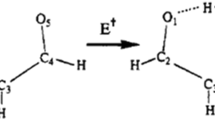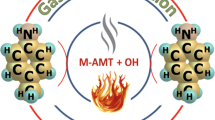Abstract
On the basis of the model of atom-atom potential functions, an approach is proposed for the evaluation and analysis of “steric factors” in nucleophilic addition reactions at the carbonyl group, in which a large number of reaction complexes differing in torsional angles and position on the reaction coordinates are considered. The effectiveness of the approach developed, both for the investigation of the stereochemistry of heterocyclic reduction of α-substituted Β- and γ-ketoesters and alkylcyclohexanones and for the evaluation of the influence of steric factors on the reactivity of diethyl malonates in alkaline hydrolysis, is demonstrated.
Similar content being viewed by others
Literature cited
V. A. Palm, Fundamentals of the Quantitative Theory of Organic Reactions [in Russian], Khimiya, Leningrad (1977).
R. V. Taft, “Separation of the influences of the polar, steric, and resonance factors on reactivity,” Steric Effects in Organic Chemistry [Russian translation], Izd-vo Inostr. Lit., Moscow (1960), pp. 562–686.
K. L. Riche and W. F. Sager, “Investigation of the equations relating the structure and reactivity of organic compounds,” in: Modern Methods of Physical Organic Chemistry [Russian translation], Mir, Moscow (1967), pp. 498–555.
V. G. Dashevskii, Conformational Analysis of Organic Molecules [in Russian], Khimiya, Moscow (1982).
V. E. Kuz'min and G. L. Kamalov, “Stereochemistry of the reduction of carbonyl compounds by complex alkali metal hydrides,” Moscow (1981), Deposited in VINITI [All-Union Institute of Scientific and Technical Information], No. 3312-81.
V. I. Galkin and R. A. Cherkasov, “Relationship of structure and reactivity. I. On the Problem of the Steric Effect,” Reakts. Sposob. Org. Soed., 18, No. 1, 111–132 (1981).
E. L. Eliel, N. L. Allinger, S. J. Angyal, and G. A. Morrison, Conformational Analysis Wiley, N. Y. (1965).
Yu. A. Kruglyak, G. G. Dyadyusha, V. A. Kuprievich, et al., Methods of Calculations of the Electronic Structure and Spectra of Molecules [in Russian], Nauk. Dumka, Kiev (1969).
G. L. Kamalov, V. N. Sharygin, V. P. Nekhoroshkov, et al., “Stereochemical peculiarities of the reduction of Β- and γ-dicarbonyl compounds,” Vopr. Stereokhim., No. 6, 106–111 (1977).
A. V. Bogatskii (Bogatskij), Yu. Yu. Samitov, A. I. Gren, and S. G. Soboleva, “Stereochemie der Heterocyclen. 31. Die Konfiguration und Bevorzugte Konformation Substituierter 4-Methyl-1,3-dioxane,” Tetrahedron, 31, No. 4, 489–494 (1975).
V. I. Sokolov, Introduction to Theoretical Stereochemistry [in Russian], Nauka, Moscow (1979).
J. D. Morrison and H. S. Mosher, Asymmetric Organic Reactions, Prentice-Hall, Englewood Cliffs, N. J. (1971).
I. Idzumi and A. Tai, Stereo-Differentiating Reactions [Russian translation], Mir, Moscow (1979).
C. Alvarez-Ibarra, F. Fernandez-Gonzalez, A. Garcia-Martinez, et al., “Generalized Curtin-Hammet principle and the elucidation of transition state type. Application to stereoselectivity in LAH reduction of alkyl-aryl-ketones,” Tetrahedron Lett., No. 29, 2715 (1973).
J. Haiosh, Complex Hydrides in Organic Chemistry [Russian translation], Khimiya, Leningrad (1971).
E. Eliel and Y. Sanda, “Reduction with metal hydrides. 19. Competitive reduction of alkylcyclohexanes regarding the concepts of steric approach control and product development control,” Tetrahedron, 26, No. 12, 2411–2428 (1970).
D. C. Wiegfield, “Stereochemistry and mechanism of ketone reductions by hydride reagents,” ibid., 35, No. 4, 449–462 (1979).
I. C. Perlberger and P. A. Müller, “A model for the transition state of the reduction of aliphatic ketones by sodium borohydride,” J. Am. Chem. Soc., 99, No. 19, 6313–6319 (1977).
V. E. Kuz'min, G. L. Kamalov, and S. M. Pluzhnik-Gladyr', “Stereochemistry of the reduction of α-methyl-γ,γ,γ-trifluoroacetoacetic ester by complex hydrides of alkali metals,” Moscow (1980), Deposited in VINITI, No. 1687-80.
V. E. Kuz'min, G. L. Kamalov, R. N. Lozitskaya, et al., “Modeling of steric interactions in nucleophilic addition reactions at the carbonyl group,” Moscow (1984), Deposited in VINITI, No. 1408-84.
W. J. Orville-Thomas, ed., Internal Rotation of Molecules, Wiley, N. Y. (1974).
G. L. Kamalov, R. N. Lozitskaya, O. I. Tishchenko, and L. N. Glinskaya, “Effects of shielding of the carbonvl group in the alkaline hydrolysis of substituted malonic esters,” in:The Use of Conformational Analysis in the Synthesis of New Organic Substances [in Russian], Odessa (1975), pp. 191–197.
G. L. Kamalov and R. N. Lozitskaya, “Reactivity of ethoxycarbonyl groups of arylidene- and alkylidene-malonic esters in alkaline hydrolysis,” Dokl. Akad. Nauk UkrSSR, Ser. B., No. 10, 44–47 (1983).
W. T. Wipke and P. Gund, “Simulation and evaluation of chemical synthesis. Congestion: a conformation-dependent function of steric environment at a reaction center. Application with torsional terms to stereoselectivity of nucleophilic additions to ketones,” J. Am. Chem. Soc., 98, No. 25, 8107–8118 (1976).
Author information
Authors and Affiliations
Additional information
Translated from Teoreticheskaya i éksperimental'naya Khimiya, Vol. 22, No. 5, pp. 610–619, September–October, 1986.
Rights and permissions
About this article
Cite this article
Kuz'min, V.E., Kamalov, G.L., Lozitskaya, R.N. et al. Analysis and estimation of “steric effects” in nucleophilic addition reactions at the carbonyl group. Theor Exp Chem 22, 584–592 (1987). https://doi.org/10.1007/BF00522545
Received:
Revised:
Issue Date:
DOI: https://doi.org/10.1007/BF00522545




